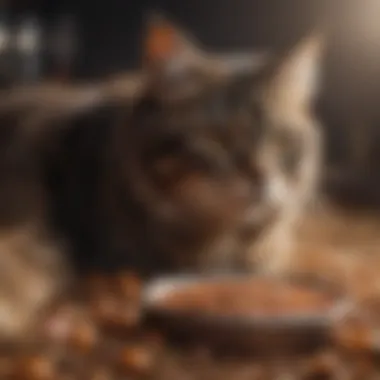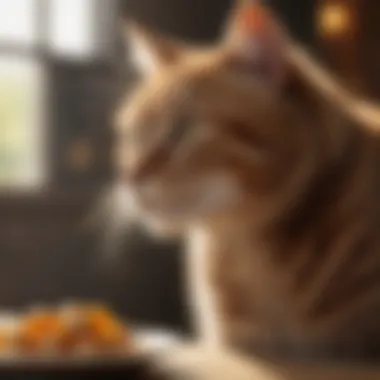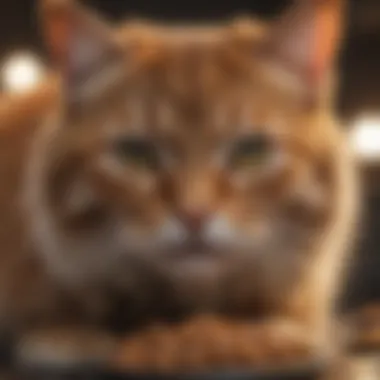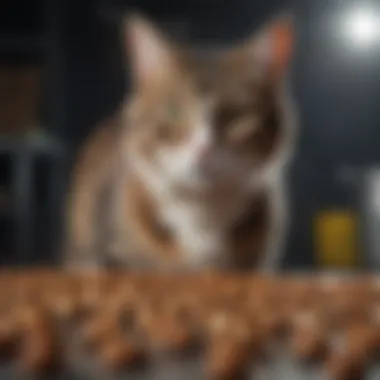Affordable Cat Food: A Comprehensive Guide for Pet Owners


Intro
Understanding the nutritional needs of our feline companions is crucial. Choosing affordable cat food does not mean skimping on quality. Many pet owners face the challenge of selecting budget-friendly options while ensuring their cat's wellbeing. This guide provides insights on key nutrients, essential ingredients, and potential drawbacks of economical cat food. By examining various brands and considering ethical production, this analysis aims to help readers make informed decisions.
Animal Overview
Common Names
Cats are commonly referred to as house cats or domestic cats. Their scientific name is Felis catus.
Scientific Classification
In the context of classification, domestic cats belong to the family Felidae. This family includes all felines, and Felis catus is specifically bred for companionship and various utility purposes.
Geographic Range
Cats are found in homes worldwide. They have adapted to various climates, showing resilience and versatility. You might spot a cat in a city apartment as easily as in a rural farmhouse.
Nutritional Requirements of Cats
Cats are obligate carnivores, meaning their diet requires a significant amount of meat. Essential nutrients include:
- Proteins: Critical for growth, maintenance, and repair of tissues.
- Fats: Provide energy and aid in the absorption of fat-soluble vitamins.
- Vitamins and Minerals: Needed for metabolic functions.
Each ingredient needs careful consideration, especially when selecting affordable options.
Key Ingredients to Consider
When exploring affordable cat food, look for products that feature:
- Animal-Based Proteins: Real meat should be the first ingredient.
- Fats from Healthy Sources: Omega fatty acids are supportive of skin and coat health.
- Whole Grains and Vegetables: These can provide additional nutrients but should not be primary components.
Being mindful of these ingredients is vital for maintaining a wholesome diet.
Potential Pitfalls of Cheap Options
Not all cheap cat foods deliver on quality. Common issues in budget brands include:
- Low-Quality Ingredients: Some contain fillers and by-products that do not contribute to nutrition.
- Insufficient Nutritional Balance: Many may lack essential vitamins and minerals needed for feline health.
- Hidden Additives: Certain preservatives might pose health risks over time.
While the price may be tempting, cost should not overshadow health considerations.
Brand Comparisons
In the market, several brands stand out for affordability without compromising health. Consider:
- Purina Cat Chow: Known for its balanced formulation.
- Meow Mix: Offers various flavors appealing to diverse palates.
- Iams: Features both dry and wet options focusing on essential nutrients.
Each brand has its nuances that cater to different needs and preferences.
Customer Reviews and Ethical Aspects
Paying attention to customer feedback is fundamental. Reviews often highlight product performance, palatability, and any adverse reactions from cats. Moreover, consider brands that commit to ethical sourcing and production. Sustainable practices and transparency strengthen a product's value.
Making informed decisions not only reflects in your cat's health but also impacts the larger ecosystem of pet food production.
Culmination
Navigating affordable cat food options requires diligence and awareness. Prioritizing your cat's nutritional needs, being attentive to ingredients, and evaluating brand practices will ensure that you provide effective care. In the end, the choices made have lasting effects on your pet's quality of life.
Understanding Cat Nutrition


Understanding cat nutrition is a fundamental aspect of ensuring the health and well-being of felines. Cats require a specialized diet due to their unique metabolic processes. Unlike other pets, they are obligate carnivores, meaning their main source of energy and nutrients should come from animal-based products. It is essential to grasp the core components of cat nutrition to choose the right food for our pets.
A well-balanced diet not only supports everyday functions but also helps in preventing nutritional deficiencies and associated health problems. Pet owners should prioritize understanding nutritional labels and ingredient compositions to navigate the myriad of affordable options on the market. By doing so, they can provide optimal nutrition without overspending.
Essential Nutrients for Cats
Cats need several essential nutrients for healthy survival and steady development. The main categories include protein, fat, vitamins, and minerals.
- Protein: Cats require a high level of protein, compared to many other animals. Protein serves as a building block for tissues and is critical for various bodily functions.
- Fats: Healthy fats provide energy and also assist in nutrient absorption. Specific fatty acids, like omega-3 and omega-6, are vital for skin and coat health.
- Vitamins: Essential vitamins, such as A, D, E, and K, play crucial roles in metabolic functions and immune system support.
- Minerals: Minerals are needed for various bodily functions, including bone health and muscle contraction. Calcium and phosphorus, for instance, are significant for strong bones.
By ensuring that these nutrients are present in their diet, cat owners can promote long-term health.
Common Nutritional Deficiencies
Nutritional deficiencies can lead to severe health issues. Some common deficiencies observed in cats include:
- Taurine Deficiency: Taurine is critical for heart and eye health. A lack of this amino acid can lead to heart disease and vision problems.
- Vitamin A Deficiency: Cats cannot convert carotenoids from plant sources into vitamin A, making it necessary to supply this vitamin from animal sources. A deficiency leads to vision issues and skin problems.
- Essential Fatty Acids Deficiency: Insufficient omega fatty acids may result in skin issues, poor coat quality, and inflammatory conditions.
Being aware of these potential deficiencies can help pet owners pick foods that fulfill all nutritional needs.
The Role of Protein in Cat Diets
Protein is the cornerstone of a cat's dietary requirements. Cats utilize protein not only for energy but also for building and repairing tissues. The majority of cats' energy comes from protein, making it essential to select food with high-quality, animal-based protein sources.
Common protein sources include:
- Chicken
- Fish
- Beef
The digestibility of these proteins is crucial. Digestible proteins provide higher bioavailability of the necessary amino acids. Moreover, when selecting affordable cat food, it is vital to look for explicit mentions of meat rather than vague terms like
Factors to Consider When Choosing Cheap Cat Food
When selecting affordable cat food, several factors must be kept in mind. It is vital to balance cost and quality effectively. Cat owners need to understand that the cheapest option isn't always the healthiest choice for their pets. Evaluating ingredients, the source of materials, and the reputation of brands can lead to better-informed decisions.
Price vs.
Quality: Finding the Balance
The relationship between price and quality can often be complex. Many pet owners may feel tempted to choose the least expensive product, believing they are saving money. However, low-cost cat food may contain fillers or low-quality ingredients. These components can lead to nutritional deficiencies or health issues for their cats.
To find the right balance, consider evaluating:
- Ingredient lists: Look for real meat as the first ingredient, rather than meat by-products or fillers like corn and grains.
- Nutritional standards: Ensure that the food meets AAFCO (Association of American Feed Control Officials) standards for complete nutrition.
- Serving sizes: Sometimes, cheaper brands require larger serving sizes to provide adequate nutrition, potentially negating their initial cost benefit.
Ingredient Quality and Source
The quality of ingredients plays a crucial role in cat food. Buying cheap food doesn't mean sacrificing nutrition if you choose wisely. Look for brands that use high-quality, natural ingredients. Source of the ingredients also matters. Knowing where the food comes from can give insight into its quality and safety. For example, brands that are transparent about their sourcing practices tend to prioritize quality and ethical production.
Some aspects to consider include:
- Meat sourcing: It is preferable to choose brands that use meats from reputable suppliers. Avoid products that do not clearly state their meat sources.
- Whole food ingredients: Natural ingredients like vegetables and whole grains can support better digestion and overall health.
- Reading labels: Understanding the ingredient label can help identify any harmful additives or preservatives.
Brand Reputation and Reviews
Brand reputation can vary greatly in the market for affordable cat food. Checking reviews from other pet owners can provide valuable insights about a brand’s products. User feedback often highlights aspects such as palatability, any observed health effects, and consistency in product quality.
Researching includes:
- Third-party reviews and ratings: Websites and forums can give a comprehensive view of what other customers experience with the brand.
- Transparency: Brands that openly share their nutritional information and respond to customer inquiries often show commitment to quality and customer service.
- Recalls and safety records: Checking if a brand has had safety recalls can also be essential in determining their reliability.
Choosing affordable cat food doesn't have to compromise the health of your pet. With a thoughtful approach that considers price, ingredient quality, and brand reliability, cat owners can make informed decisions that ensure their feline companions receive proper nutrition without overspending.
Top Affordable Cat Food Brands


Choosing the right cat food is a critical aspect of pet ownership. Affordable cat food brands often provide a wide range of options that can meet the nutritional needs of cats without putting a strain on your wallet. This section will examine specific brands that stand out in terms of quality, ingredient sourcing, and customer satisfaction.
In this article, we will highlight three notable brands: Brand A, Brand B, and Brand C. Each brand has its own unique characteristics, allowing pet owners to make informed choices based on their feline’s requirements and preferences. Understanding the benefits and considerations for each option can lead to better long-term health for pets.
Brand A: Product Overview
Brand A offers a selection of cat food that is both affordable and widely accessible. Known for its reliable ingredient sourcing, this brand focuses on delivering a well-rounded nutritional profile. The product line includes dry kibbles and wet food options which cater to various dietary needs. Customers often appreciate the balance of protein, fats, and carbohydrates in Brand A's formulas.
Key Features:
- Wide range of product forms.
- Focus on protein-rich content, featuring real meat as the primary ingredient.
- Fortified with vitamins and minerals essential for overall health.
Brand B: Nutritional Analysis
Brand B stands out due to its emphasis on nutritional quality. The brand focuses on meat-based proteins, which aligns well with the natural dietary habits of cats. With a strong commitment to avoiding synthetic additives, Brand B formulates its recipes using whole food ingredients. This approach allows for a more honest representation of what is in the food.
Nutritional Highlights:
- Primary ingredients sourced from high-quality meat sources.
- Very low percentages of fillers like corn and wheat.
- Enhanced with omega fatty acids for a healthy coat.
Brand C: Customer Feedback
Brand C garners significant attention in reviews. Customers frequently comment on their cats’ increased energy and overall health. While some users mention high palatability as a selling point, others appreciate the transparency of the ingredients list. Often, Brand C receives praise for its affordability without compromising on quality.
Customer Insights:
- Many owners report a visible difference in their cat's coat health after switching.
- Positive remarks about easy digestion and lack of food sensitivities.
- Some users suggest the need for more variety in flavors to cater to picky eaters.
Evidently, selecting the right brand is crucial for ensuring a healthy diet for your cat. Each brand discussed in this section brings unique advantages, making them worthy considerations for budget-conscious pet owners.
Comparing Ingredients in Affordable Cat Food
Understanding the ingredients in affordable cat food is essential for pet owners aiming to provide their felines with proper nutrition. Every cat has unique dietary needs that must be met to maintain their health and vitality. In this section, we will examine key components found in budget-friendly cat food options. The comparison will illustrate how different ingredients can affect cat health, their overall well-being, and the implications of choosing cheaper alternatives.
Meat-Based vs.
Grain-Based Proteins
Cats are obligate carnivores, meaning their diet primarily requires meat proteins. The main difference between meat-based and grain-based proteins lies in their amino acid profiles.
- Meat-Based Proteins: These are closer to a cat's natural diet, providing essential nutrients like taurine, which is vital for heart and eye health. Common sources include chicken, beef, and fish. Products that list meat as the first ingredient tend to provide a complete and balanced diet.
- Grain-Based Proteins: These often come from corn, wheat, or soy and may be used to fill the food without providing adequate nutrition. While these can offer some protein, they do not contain all the essential amino acids that cats need. Feeding a cat primarily grain-based protein can lead to nutritional deficiencies over time.
In summary, when comparing cheap cat food, prioritize those that have meat-based proteins as their primary ingredient to ensure your cat gets the necessary nutrients.
Artificial Additives and Preservatives
Artificial additives and preservatives are often included in lower-cost cat foods to enhance flavor or maintain shelf life. While some may be beneficial, others can pose risks to a cat's health. It is crucial to identify and understand these ingredients when selecting inexpensive options.
Some common types of additives include:
- Flavor enhancers: These are used to make food more palatable but may not add nutritional value.
- Preservatives like BHA or BHT: These synthetic compounds can improve shelf life but have raised concerns over long-term health impacts in animals.
- Colorants: These add visual appeal but offer no nutritional benefit.
It is advisable to avoid food with multiple artificial ingredients, as a clean ingredient list often indicates better overall quality and safety for your cat.
The Importance of Fatty Acids
Fatty acids are another critical aspect of cat nutrition often overlooked in budget foods. These components are essential for maintaining healthy skin, a shiny coat, and overall cellular health. Specifically, Omega-3 and Omega-6 fatty acids play crucial roles in anti-inflammatory responses and supporting brain health.
- Sources of Fatty Acids: Fish oil, flaxseed oil, and certain animal fats are good sources of these acids. Look for foods that specify these ingredients, as they can lead to better health outcomes for your cat.
- Deficiency Effects: A diet lacking in these fatty acids can lead to dry skin, dull fur, and may compromise the immune system.
In selecting affordable cat food, ensure that fatty acids are included, as they contribute to your cat's long-term health and vitality.


In summary, understanding the differences in ingredients, particularly regarding protein types, additives, and fatty acids, you can make more informed choices about affordable cat food that supports your feline's well-being.
Reading Labels: What to Look For
Understanding cat food labels is crucial for any pet owner. When choosing affordable cat food, labels can reveal a lot about what you're offering your cat. It is not just about price; it also involves nutrition, quality, and safety. By carefully examining these labels, pet owners can make sound decisions that align with their cat's dietary needs and health goals.
Understanding Cat Food Labels
Cat food labels are often packed with information. They typically include the brand name, the product name, and nutritional claims. This section outlines what to focus on when reading these labels.
First, look for the guaranteed analysis. This part breaks down the percentages of protein, fat, fiber, and moisture in the food. It helps you assess whether the product meets your cat's nutritional requirements. Remember, a cat is a carnivore and needs a diet that reflects this.
Next, ingredients should be listed in order of weight. The first few ingredients usually dominate the food. Therefore, it is wise to understand the main sources in your cat's diet.
Finally, be wary of marketing jargon. Terms like
Potential Risks of Cheap Cat Food
The selection of budget-friendly cat food might seem appealing at first glance. However, there are significant risks associated with choosing low-cost options. Understanding these potential pitfalls is crucial for pet owners who prioritize their cats' health and well-being. While affordability is a practical consideration, the consequences of feeding substandard food can be dire.
Health Risks Associated with Low-Quality Food
Low-quality cat food often contains fillers and artificial additives that can negatively impact a cat's health. These products may lack essential nutrients that cats require for proper functioning. In particular, an excess of carbohydrates and sugars can lead to obesity, diabetes, and digestive issues. It is important to scrutinize the ingredient lists to identify subpar components.
- Common Health Issues: Cats fed low-quality diets may experience:
- Vomiting and diarrhea
- Allergies and skin problems
- Malnutrition
When investigating these health risks, cats are more susceptible to infections and diseases. Malnourishment can weaken their immune system, making them vulnerable to conditions that could have been prevented with a balanced diet.
Long-Term Effects on Cat Health
The long-term effects of a poor diet can become evident over time. Cats may suffer from chronic conditions related to nutritional deficiencies. For example, prolonged exposure to inadequate eating can lead to kidney disease or urinary tract issues. This scenario creates a cycle of medical expenses and emotional strain for pet owners.
Moreover, our feline companions may display behavioral changes. Cats that do not receive adequate nutrition often exhibit lethargy, irritability, or a lack of interest in play. This can strain the bond between the pet and owner, potentially leading to more serious behavioral problems.
Ethical Concerns in Cat Food Production
Equally concerning are the ethical implications of producing cheap cat food. Many budget brands can cut costs by sourcing ingredients from questionable suppliers. The production process may involve animal suffering or neglecting sustainable practices. As pet owners become more aware of these issues, they often seek brands that prioritize ethics alongside nutrition.
- Key Ethical Considerations:
- Sourcing of ingredients from unethical or environmentally detrimental farms
- Lack of transparency in production and supply chain
- Involvement in practices that harm animals or their habitats
Strategies for Cost-Effective Cat Feeding
Choosing budget-friendly cat food does not merely hinge on finding the cheapest options available. It is about strategically planning your purchases while ensuring that your cat's nutritional needs are still met. Understanding and applying effective feeding strategies can lead to more economical and health-conscious choices. This section elaborates on essential strategies that can help you manage your cat's dietary requirements without straining your finances.
Bulk Purchasing Options
Buying cat food in bulk can be a significant money-saver. Retailers often provide discounts when you purchase larger quantities, which can lead to reduced per-unit costs. When opting for bulk purchases, consider your cat's dietary preferences and how long the food will last.
- Shelf Life: Ensure that you buy products that will remain fresh for the duration you will be using them. Check expiration dates to avoid wastage.
- Storage: Proper storage is crucial when buying in bulk. Use airtight containers to preserve freshness and protect the food from pests.
- Reputable Suppliers: When sourcing bulk cat food, prioritize established suppliers known for their quality products.
Homemade Cat Food Alternatives
For those looking to save money while ensuring quality, homemade cat food can be an appealing option. Crafting your cat’s meals allows you to choose ingredients, ensuring they meet nutritional standards. However, this must be approached with caution.
- Balance: Homemade food must contain the right proportions of nutrients, including proteins, fats, and vitamins. Consulting with a veterinarian or a pet nutritionist is advisable.
- Cost Analysis: Calculate the cost of ingredients and compare it to the commercial options. Sometimes, the cost might not vary significantly.
- Safety: Always prioritize food safety. Avoid using ingredients that are toxic to cats, such as onions and garlic.
Understanding Portion Control
Portion control is critical in maintaining your cat's health and managing costs. Feeding the right amount can prevent obesity and waste. Overfeeding leads to unnecessary expenses and potential health issues.
- Serving Sizes: Refer to the feeding guidelines provided on commercial cat food labels for portion sizes. Adjust the portions based on your cat's age, weight, and activity level.
- Scheduled Feeding: Establishing a routine can help manage portions effectively. Instead of leaving food out all day, consider scheduled feeding times.
Remember, a healthy cat is a happy cat. Managing feeding strategies mindfully can prolong your feline’s life and keep veterinary bills at bay.
In summary, the strategies for cost-effective cat feeding not only help ensure that you are making the most out of your budget but also play a crucial role in maintaining your cat’s health. By considering bulk options, exploring homemade meals, and embracing portion control, you can promote a healthier lifestyle for your pet while being financially responsible.







